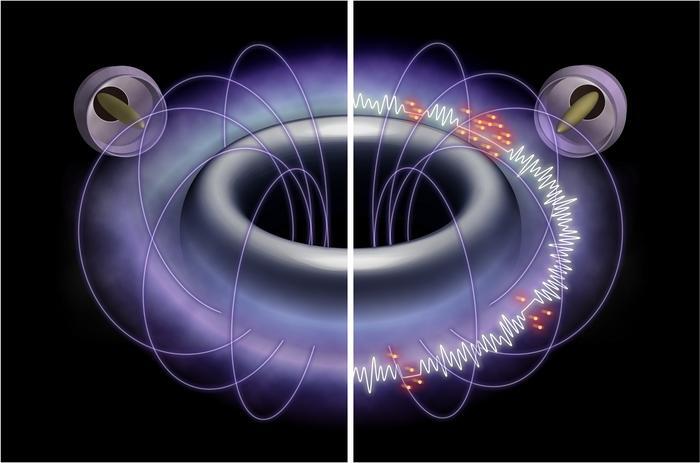23.03.2024

Observation of spontaneous chorus emission in RT-1: When the plasma confined in the dipole magnetic field of RT-1 contains a significant fraction of high-temperature electrons (red particles), a chorus emission (white emission lines) forms with a variable frequency (sound height) similar to birdsong. Courtesy: National Institute for Fusion Science
Space weather events known as whistler mode chorus emissions have been observed in the laboratory for the first time. These emissions occur naturally within regions of space dominated by planetary magnetic fields – magnetospheres – and they are related to the aurorae that light up our northern and southern skies every winter. However, their exact origins are poorly understood, and until now, studying them has involved either spacecraft observations or numerical simulations. By recreating the conditions that produce these emissions, researchers at Japan’s National Institute for Fusion Science and the University of Tokyo hope to better understand them and how they affect orbiting satellites as well as ground-based power and communication networks.
Whistler mode chorus emissions are intense, coherent waves that produce and transport high-energy electrons through planetary magnetospheres. They get their name because their frequencies vary repeatedly in a way that reminded early researchers of the “dawn chorus” of birdsong. These plasma waves have been observed in Jupiter’s magnetosphere and in the region affected by Earth’s magnetic field, but never before under controlled conditions in a laboratory.
Recreating magnetosphere-type plasmas
The first task for team leaders Haruhiko Saitohand Zensho Yoshida was to create a suitably magnetosphere-mimicking magnetic field. The most fundamental type of magnetic field that forms in planetary magnetospheres is a dipole field, and at the University of Tokyo’s Ring Trap 1 (RT-1) facility, this type of field is commonly used to stably confine plasmas for advanced fusion experiments.
In their work, which they describe in Nature Communications, Saitoh and colleagues generated this field using a 110-kg magnetically levitated superconducting coil located within the RT-1’s vacuum vessel. By filling the vacuum vessel with hydrogen gas and exciting the gas with microwaves, they created a high-quality hydrogen plasma containing electrons heated to high temperatures. “Creating an environment similar to the magnetosphere in the laboratory was challenging,” Saitoh tells Physics World, “but RT-1 is able to achieve this thanks to the levitating superconducting coil in a vacuum chamber.”
Chorus emissions could be a universal phenomenon
The researchers used magnetic probes to study how the plasma – including the hot electron component – fluctuates. They found that the plasma spontaneously produced whistler wave chorus emissions whenever it contained a significant proportion of high-temperature electrons. These electrons are responsible for the plasma’s pressure, and the team observed that increasing their number drives the generation of chorus emissions.
According to the researchers, this result suggests that chorus emissions are a universal phenomenon in plasmas that contain high-temperature electrons within a simple dipole magnetic field. Plasmas of this type are common in the geospace, which the team define as “the space around the Earth that is particularly closely linked to human activities”. As such activities intensify, they note, the study of magnetospheric disturbances capable of causing aurorae, as well as power and communication failures, becomes more important. “Chorus emissions are important for understanding and potentially mitigating these effects,” they say.
Quelle: Physics World
